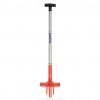Easy to identify due to its bright yellow flowers, ragwort, also known as Senecio jacobea, is a common weed that plagues paddocks throughout Britain.
Ragwort is dangerous to horses because it contains the toxic compounds pyrrolizidine alkaloids, which are poisonous and damage the liver when eaten.
The toxic effect builds up over time, causing irreversible damage and in some cases death. Your horse will get just as ill from eating small amounts of ragwort over a long period of time as it would do from eating a large quantity in one go.
“While most horses won’t immediately choose to eat ragwort due to it’s bitter taste, some develop a taste for it if nothing else is available,” explains Gemma Stanford, the British Horse Society’s (BHS) director of welfare. “It also loses its unpalatable taste if it’s cut and dried and found in forage, but it’s still toxic.”
Keeping ragwort under control
If left to grow, ragwort can spread quickly and easily which means keeping on top of its growth is vital.
The plant is biennial (flowers every two years) and its seeds lie dormant in the ground which means removal of the plant is required annually for at least two years until the weed is brought under control. A combination of methods is often necessary to fully remove it.
“A herbicide is one option of removing ragwort and should be used at the rosette stage in spring, but horses need to be removed from the pasture being sprayed, and only approved products should be used (a list can be found at pesticides.gov.uk) as some products require a qualified specialist to apply them,” explains Gemma. “We always advise wearing gloves when handling ragwort due to is toxicity.”
Other options include improving the pasture — ragwort thrives on poor quality pasture so improving the grass growth will make it harder for it to grow.
Pulling the plant by hand before it has flowered is another option for smaller parcels of land, but you must ensure every part of the root is removed — any fragments left will enable it to re-grow. Pulling when the soil is damp makes the job easier and more efficient.
How to dispose of ragwort safely
A flowering ragwort plant can still go to seed after being pulled, so it should be placed in an enclosed container or bag — paper feed bags are ideal as they can be burnt.
“An important part of control is the safe and effective disposal of the plant to help reduce the risk of further spread,” Gemma advises. “The amount of ragwort to be disposed of, the facilities available on-site and local resources available will affect your disposal options.”
There are three main options for disposal: controlled burning in small quantities and a safe location away from buildings and animals; rotting in a secure compost bin or similar with a lid; and using a waste-management company who will remove the ragwort for you.
You might also like:

Had enough of annoying flies? We’ve tested some fly sprays to find which really work

Poisonous plants you need to know about [H&H VIP]
Find out about the toxic plants you need to keep an eye out for this spring

Subscribe to Horse & Hound magazine today – and enjoy unlimited website access all year round
Horse & Hound magazine, out every Thursday, is packed with all the latest news and reports, as well as interviews, specials, nostalgia, vet and training advice. Find how you can enjoy the magazine delivered to your door every week, plus options to upgrade your subscription to access our online service that brings you breaking news and reports as well as other benefits.



